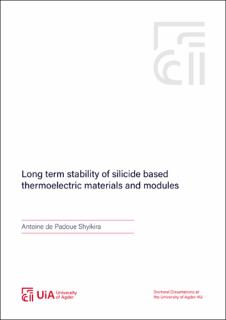| dc.contributor.author | de Padoue Shyikira, Antoine | |
| dc.date.accessioned | 2023-05-03T11:56:14Z | |
| dc.date.available | 2023-05-03T11:56:14Z | |
| dc.date.created | 2023-05-02T09:55:03Z | |
| dc.date.issued | 2023 | |
| dc.identifier.citation | de Padoue Shyikira, A. (2023). Long term stability of silicide based thermoelectric materials and modules [Doctoral dissertation]. University of Agder. | en_US |
| dc.identifier.isbn | 978-82-8427-127-9 | |
| dc.identifier.issn | 1504-9272 | |
| dc.identifier.uri | https://hdl.handle.net/11250/3065998 | |
| dc.description.abstract | Silicide-based thermoelectric generators are potential candidates for waste heat recovery at temperatures below 500 C. For the last two decades, the conversion efficiency of modules based on n-type magnesium silicides and p-type higher manganese silicide has improved significantly. However, the conditions in which thermoelectric generators operate (for example, remote areas in the oil, gas, and telecommunication industries, in automobiles, etc.) are harsh (corrosive, for example) and hostile (due to thermal instability). In this project, there was much focus on the stability of the thermoelectric modules, with special interest given to oxidation of the thermoelectric materials and module stability. The thermal oxidation studies were conducted on higher manganese silicide alloys; the studies mainly investigated the effect of the alloys’ composition, consolidation techniques and the operational atmosphere’s effect on their oxidation potential. Moreover, the choice of matching electrodes and good bonding technology for the module assembly was the ultimate step before finally testing the actual performance and stability of the module over an extended period. The thorough oxidation studies conducted in this thesis revealed the importance of different production processes for the higher manganese silicide thermoelectric materials on the oxidation robustness of the alloys. The study showed that the purity (fewer impurities) of the raw elements and optimal doping level are among the key factors for the alloys to resist oxidation by growing a protective SiO2 protective oxide layer. Moreover, it was also shown that powder consolidation by spark plasma sintering produced stronger bulk pellets, and mechanical strength played a key role in passive oxidation. During the module’s contacts design, silver electrodes and solid liquid interdiffusion bonding technology were used. The contact resistance of the assembled modules were measured using an automated point contact measurement test rig. On the magnesium silicide the specific contact resistance was on average 0.17 m cm2 with 2.1% standard deviation. The higher manganese silicide’s contact interface, on the other hand, the results were dispersed along the bond, where 0.07 m cm2 was the lowest value and 1.12 m cm2 the highest (81.3% standard deviation). Finally, the module stability was investigated by testing the performance of the assembled modules. The tested modules produced up to 7.4mW/cm2 power density at 400 C and sustained more than 300 thermal cycles. The gradual degradation was found to mainly originate from the mechanical failure of the contact interfaces and oxidation of the n-type magnesium silicide relative to the p-type material. Applying a high-temperature coating did not reduce the degradation rate, which showed that it would be better to encapsulate the modules to count-act the effect of oxidation. | en_US |
| dc.language.iso | eng | en_US |
| dc.publisher | University of Agder | en_US |
| dc.relation.ispartofseries | Doctoral Dissertations at the University of Agder; no. 412 | |
| dc.relation.haspart | Paper I: de Padoue Shyikira, A., Skomedal, G. & Middleton, P. H. (2020). Performance evaluation and stability of silicide-based thermoelectric modules. Materials Today: Proceedings, 44(4), 3467-3474. https://doi.org/10.1016/j.matpr.2020.05.193. Published version. Full-text is available in AURA as a separate file: https://hdl.handle.net/11250/3065993. | en_US |
| dc.relation.haspart | Paper II: de Padoue Shyikira, A., Akhtar, N., Skomedal, G., Sætre, T. O. & Middleton, P. H. (2021). High temperature oxidation of higher manganese silicides. Corrosion Science, 185: 109327. https://doi.org/10.1016/j.corsci.2021.109327. Published version. Full-text is available in AURA as a separate file: https://hdl.handle.net/11250/2837304. | en_US |
| dc.relation.haspart | Paper III: de Padoue Shyikira, A., Akhtar, N., Skomedal, G., & Hugh Middleton, P. (2021). The effect of Mo and Ge reactive elements on high-temperature oxidation of higher manganese silicide. Corrosion Science, 194: 13. https://doi.org/10.1016/j.corsci.2021.109920. Published version. Full-text is available in AURA as a separate file: https://hdl.handle.net/11250/2989948. | en_US |
| dc.rights | Attribution-NonCommercial-NoDerivatives 4.0 Internasjonal | * |
| dc.rights.uri | http://creativecommons.org/licenses/by-nc-nd/4.0/deed.no | * |
| dc.title | Long term stability of silicide based thermoelectric materials and modules | en_US |
| dc.type | Doctoral thesis | en_US |
| dc.description.version | publishedVersion | en_US |
| dc.rights.holder | © 2023 Antoine de Padoue Shyikira | en_US |
| dc.subject.nsi | VDP::Teknologi: 500::Elektrotekniske fag: 540 | en_US |
| dc.source.pagenumber | 211 | en_US |
| dc.source.issue | 412 | en_US |
| dc.identifier.cristin | 2144622 | |




